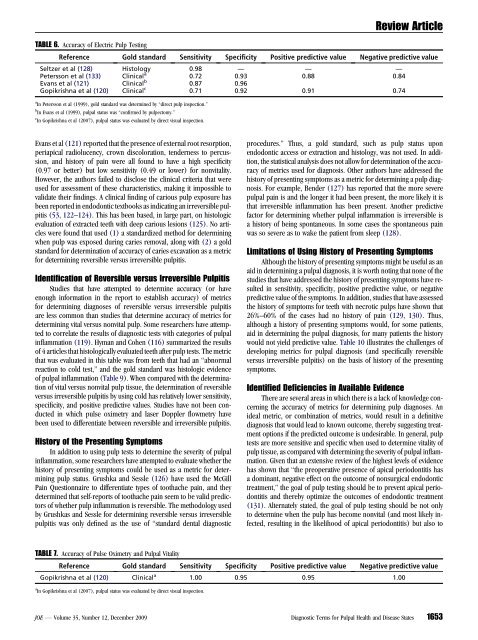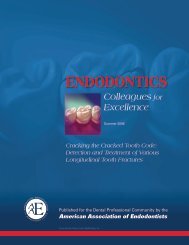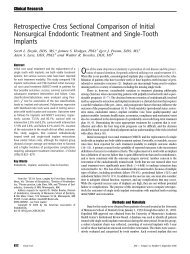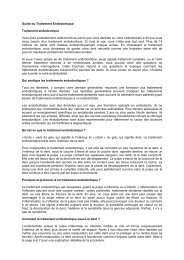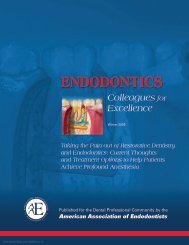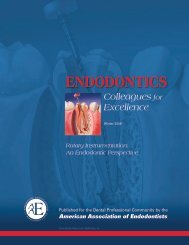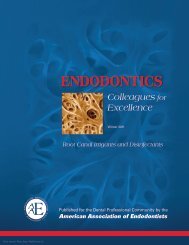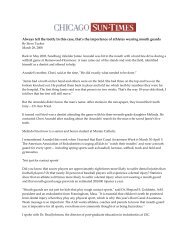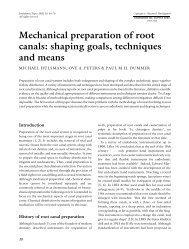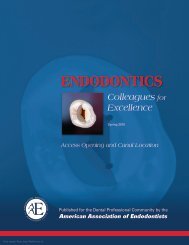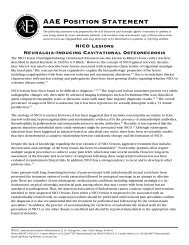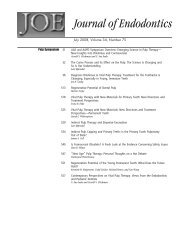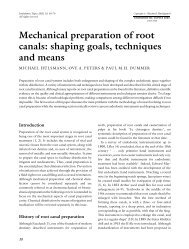Identify and Define All Diagnostic Terms for Pulpal - American ...
Identify and Define All Diagnostic Terms for Pulpal - American ...
Identify and Define All Diagnostic Terms for Pulpal - American ...
Create successful ePaper yourself
Turn your PDF publications into a flip-book with our unique Google optimized e-Paper software.
TABLE 6. Accuracy of Electric Pulp Testing<br />
Reference Gold st<strong>and</strong>ard Sensitivity Specificity Positive predictive value Negative predictive value<br />
Seltzer et al (128) Histology 0.98 — — —<br />
Petersson et al (133) Clinical a<br />
0.72 0.93 0.88 0.84<br />
Evans et al (121) Clinical b<br />
0.87 0.96<br />
Gopikrishna et al (120) Clinical c<br />
0.71 0.92 0.91 0.74<br />
a<br />
In Petersson et al (1999), gold st<strong>and</strong>ard was determined by ‘‘direct pulp inspection.’’<br />
b<br />
In Evans et al (1999), pulpal status was ‘‘confirmed by pulpectomy.’’<br />
c<br />
In Gopikrishna et al (2007), pulpal status was evaluated by direct visual inspection.<br />
Evans et al (121) reported that the presence of external root resorption,<br />
periapical radiolucency, crown discoloration, tenderness to percussion,<br />
<strong>and</strong> history of pain were all found to have a high specificity<br />
(0.97 or better) but low sensitivity (0.49 or lower) <strong>for</strong> nonvitality.<br />
However, the authors failed to disclose the clinical criteria that were<br />
used <strong>for</strong> assessment of these characteristics, making it impossible to<br />
validate their findings. A clinical finding of carious pulp exposure has<br />
been reported in endodontic textbooks as indicating an irreversible pulpitis<br />
(53, 122–124). This has been based, in large part, on histologic<br />
evaluation of extracted teeth with deep carious lesions (125). No articles<br />
were found that used (1) a st<strong>and</strong>ardized method <strong>for</strong> determining<br />
when pulp was exposed during caries removal, along with (2) a gold<br />
st<strong>and</strong>ard <strong>for</strong> determination of accuracy of caries excavation as a metric<br />
<strong>for</strong> determining reversible versus irreversible pulpitis.<br />
Identification of Reversible versus Irreversible Pulpitis<br />
Studies that have attempted to determine accuracy (or have<br />
enough in<strong>for</strong>mation in the report to establish accuracy) of metrics<br />
<strong>for</strong> determining diagnoses of reversible versus irreversible pulpitis<br />
are less common than studies that determine accuracy of metrics <strong>for</strong><br />
determining vital versus nonvital pulp. Some researchers have attempted<br />
to correlate the results of diagnostic tests with categories of pulpal<br />
inflammation (119). Hyman <strong>and</strong> Cohen (116) summarized the results<br />
of 4 articles that histologically evaluated teeth after pulp tests. The metric<br />
that was evaluated in this table was from teeth that had an ‘‘abnormal<br />
reaction to cold test,’’ <strong>and</strong> the gold st<strong>and</strong>ard was histologic evidence<br />
of pulpal inflammation (Table 9). When compared with the determination<br />
of vital versus nonvital pulp tissue, the determination of reversible<br />
versus irreversible pulpitis by using cold has relatively lower sensitivity,<br />
specificity, <strong>and</strong> positive predictive values. Studies have not been conducted<br />
in which pulse oximetry <strong>and</strong> laser Doppler flowmetry have<br />
been used to differentiate between reversible <strong>and</strong> irreversible pulpitis.<br />
History of the Presenting Symptoms<br />
In addition to using pulp tests to determine the severity of pulpal<br />
inflammation, some researchers have attempted to evaluate whether the<br />
history of presenting symptoms could be used as a metric <strong>for</strong> determining<br />
pulp status. Grushka <strong>and</strong> Sessle (126) have used the McGill<br />
Pain Questionnaire to differentiate types of toothache pain, <strong>and</strong> they<br />
determined that self-reports of toothache pain seem to be valid predictors<br />
of whether pulp inflammation is reversible. The methodology used<br />
by Grushkas <strong>and</strong> Sessle <strong>for</strong> determining reversible versus irreversible<br />
pulpitis was only defined as the use of ‘‘st<strong>and</strong>ard dental diagnostic<br />
procedures.’’ Thus, a gold st<strong>and</strong>ard, such as pulp status upon<br />
endodontic access or extraction <strong>and</strong> histology, was not used. In addition,<br />
the statistical analysis does not allow <strong>for</strong> determination of the accuracy<br />
of metrics used <strong>for</strong> diagnosis. Other authors have addressed the<br />
history of presenting symptoms as a metric <strong>for</strong> determining a pulp diagnosis.<br />
For example, Bender (127) has reported that the more severe<br />
pulpal pain is <strong>and</strong> the longer it had been present, the more likely it is<br />
that irreversible inflammation has been present. Another predictive<br />
factor <strong>for</strong> determining whether pulpal inflammation is irreversible is<br />
a history of being spontaneous. In some cases the spontaneous pain<br />
was so severe as to wake the patient from sleep (128).<br />
Limitations of Using History of Presenting Symptoms<br />
Although the history of presenting symptoms might be useful as an<br />
aid in determining a pulpal diagnosis, it is worth noting that none of the<br />
studies that have addressed the history of presenting symptoms have resulted<br />
in sensitivity, specificity, positive predictive value, or negative<br />
predictive value of the symptoms. In addition, studies that have assessed<br />
the history of symptoms <strong>for</strong> teeth with necrotic pulps have shown that<br />
26%–60% of the cases had no history of pain (129, 130). Thus,<br />
although a history of presenting symptoms would, <strong>for</strong> some patients,<br />
aid in determining the pulpal diagnosis, <strong>for</strong> many patients the history<br />
would not yield predictive value. Table 10 illustrates the challenges of<br />
developing metrics <strong>for</strong> pulpal diagnosis (<strong>and</strong> specifically reversible<br />
versus irreversible pulpitis) on the basis of history of the presenting<br />
symptoms.<br />
Identified Deficiencies in Available Evidence<br />
There are several areas in which there is a lack of knowledge concerning<br />
the accuracy of metrics <strong>for</strong> determining pulp diagnoses. An<br />
ideal metric, or combination of metrics, would result in a definitive<br />
diagnosis that would lead to known outcome, thereby suggesting treatment<br />
options if the predicted outcome is undesirable. In general, pulp<br />
tests are more sensitive <strong>and</strong> specific when used to determine vitality of<br />
pulp tissue, as compared with determining the severity of pulpal inflammation.<br />
Given that an extensive review of the highest levels of evidence<br />
has shown that ‘‘the preoperative presence of apical periodontitis has<br />
a dominant, negative effect on the outcome of nonsurgical endodontic<br />
treatment,’’ the goal of pulp testing should be to prevent apical periodontitis<br />
<strong>and</strong> thereby optimize the outcomes of endodontic treatment<br />
(131). Alternately stated, the goal of pulp testing should be not only<br />
to determine when the pulp has become nonvital (<strong>and</strong> most likely infected,<br />
resulting in the likelihood of apical periodontitis) but also to<br />
TABLE 7. Accuracy of Pulse Oximetry <strong>and</strong> <strong>Pulpal</strong> Vitality<br />
Reference Gold st<strong>and</strong>ard Sensitivity Specificity Positive predictive value Negative predictive value<br />
Gopikrishna et al (120) Clinical a<br />
1.00 0.95 0.95 1.00<br />
a In Gopikrishna et al (2007), pulpal status was evaluated by direct visual inspection.<br />
Review Article<br />
JOE — Volume 35, Number 12, December 2009 <strong>Diagnostic</strong> <strong>Terms</strong> <strong>for</strong> <strong>Pulpal</strong> Health <strong>and</strong> Disease States 1653


